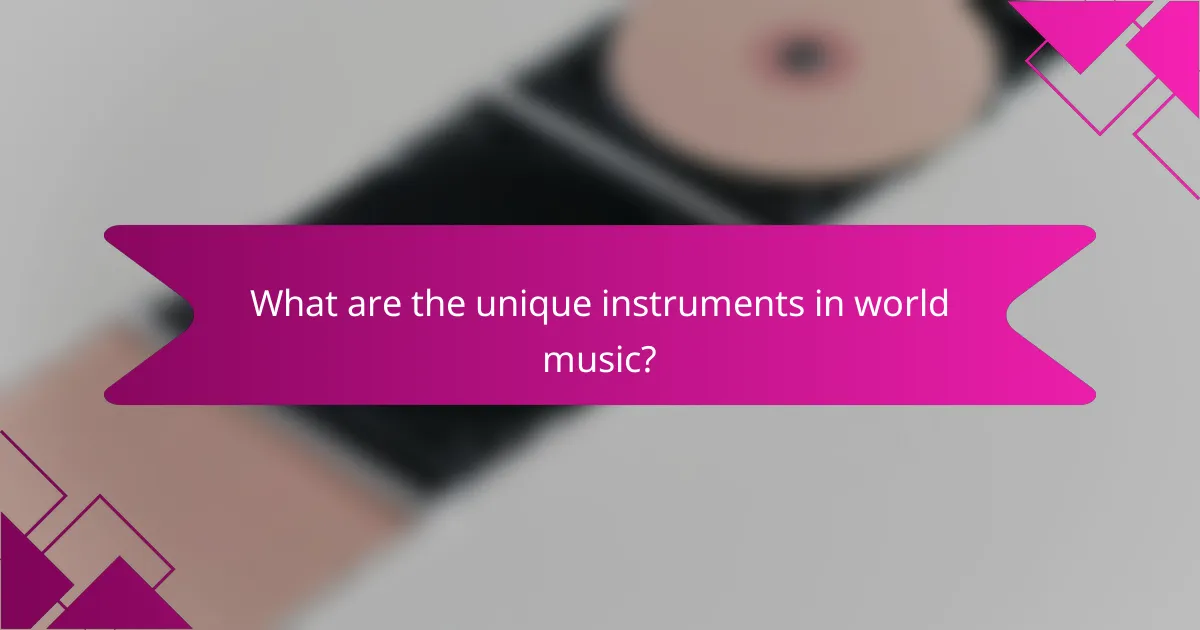World music serves as a vibrant tapestry that weaves together diverse musical traditions, reflecting the unique identities and cultural narratives of various communities. Through the use of distinctive instruments and rhythms, it fosters understanding and appreciation among different societies, while modern digital tools enhance access to these rich musical experiences.

How does world music influence cultural representation?
World music plays a significant role in cultural representation by blending diverse musical traditions and showcasing the unique identities of various communities. It serves as a platform for expressing cultural narratives and fostering understanding among different societies.
Global fusion of musical styles
The global fusion of musical styles occurs when artists incorporate elements from various cultural backgrounds into their work. This blending often results in new genres that reflect a mix of traditions, such as reggae fusion or Afrobeat. By combining instruments and rhythms from different cultures, musicians create innovative sounds that resonate with a broader audience.
For example, the collaboration between Western pop and traditional African music has led to the rise of artists who use indigenous instruments alongside modern production techniques. This fusion not only enriches the music but also promotes cross-cultural dialogue.
Representation of cultural identities
World music serves as a powerful medium for representing cultural identities, allowing artists to express their heritage and personal stories. Through lyrics, melodies, and instrumentation, musicians convey the values, struggles, and joys of their communities. This representation fosters pride and awareness among listeners, encouraging appreciation for diverse cultures.
Artists like Buena Vista Social Club and Ravi Shankar have brought their cultural backgrounds to the forefront, showcasing traditional sounds while appealing to global audiences. Such representation helps preserve cultural heritage and introduces listeners to new perspectives.
Impact on social movements
World music has historically played a crucial role in social movements, often serving as a rallying cry for change. Songs that address social justice, human rights, and political issues can mobilize communities and raise awareness on a global scale. Music becomes a tool for activism, uniting people around shared causes.
For instance, the anti-apartheid movement in South Africa saw musicians like Miriam Makeba use their art to fight for equality and justice. Similarly, contemporary artists continue to leverage their platforms to address issues such as climate change and racial inequality, demonstrating the enduring power of music in advocacy.

What are the unique instruments in world music?
Unique instruments in world music reflect the diverse cultural heritage and traditions of different regions. These instruments often embody the sounds and rhythms that define local music styles, showcasing a rich tapestry of creativity and expression.
Traditional instruments by region
Each region of the world boasts traditional instruments that are integral to its musical identity. For example, the sitar from India is known for its complex melodies, while the djembe from West Africa provides a powerful rhythmic foundation. In South America, the charango, a small string instrument, is often made from the shell of an armadillo and is used in folk music.
In Asia, instruments like the erhu from China and the shakuhachi from Japan highlight the unique tonal qualities and playing techniques that characterize their respective cultures. These instruments not only produce distinct sounds but also often carry historical and cultural significance.
Innovative modern adaptations
Modern musicians frequently adapt traditional instruments to create new sounds and genres. For instance, the electric guitar has been blended with traditional African rhythms, resulting in a fusion of styles that appeals to contemporary audiences. Similarly, the use of digital technology allows for the manipulation of sounds from traditional instruments, leading to innovative compositions.
Collaborations between artists from different backgrounds often result in the creation of hybrid instruments, which combine elements from various cultures. This not only preserves the essence of traditional music but also introduces it to new audiences in fresh and exciting ways.
Examples of iconic instruments
Some instruments have become iconic symbols of their cultures. The bagpipes of Scotland are instantly recognizable and are often associated with traditional Scottish music and ceremonies. The didgeridoo from Australia is another example, known for its deep, resonant sound and cultural significance among Indigenous Australians.
In the realm of percussion, the tabla from India stands out for its intricate rhythms and versatility, often used in classical and contemporary music alike. These instruments not only represent their regions but also serve as a bridge connecting diverse musical traditions around the globe.

How can digital products enhance world music experiences?
Digital products significantly enhance world music experiences by providing access to diverse genres, educational resources, and immersive performances. These tools allow users to explore cultural representations and unique instruments from around the globe, making world music more accessible than ever.
Streaming platforms for global music
Streaming platforms like Spotify, Apple Music, and YouTube Music offer vast libraries of world music, allowing listeners to discover artists and genres from different cultures. These services often curate playlists that highlight regional sounds, making it easier to explore specific musical traditions.
Many platforms also provide features such as personalized recommendations and user-generated playlists, which can introduce listeners to lesser-known artists and styles. Subscriptions typically range from free ad-supported models to premium plans costing around $10 to $15 per month.
Online courses for learning instruments
Online courses for learning world instruments, such as the sitar, djembe, or didgeridoo, are widely available on platforms like Udemy, Skillshare, and Coursera. These courses often include video tutorials, sheet music, and community forums for interaction with instructors and fellow learners.
Prices for these courses can vary, typically ranging from $20 to several hundred dollars depending on the depth of the material. Many platforms also offer free trials or introductory lessons, allowing potential students to gauge their interest before committing.
Virtual reality concerts
Virtual reality (VR) concerts provide an immersive way to experience live performances from around the world. Platforms like Oculus Venues and Wave allow users to attend concerts in a virtual space, often featuring artists from diverse musical backgrounds.
While VR headsets can be a significant investment, with prices starting around $300, the experience can replicate the atmosphere of a live concert, offering unique interactions and perspectives. Users should ensure they have a stable internet connection to avoid disruptions during these events.

What are the key genres in world music?
World music encompasses a variety of genres that reflect the diverse cultural influences and traditions from around the globe. Key genres include African rhythms, Latin American styles, and Asian classical music, each showcasing unique instruments and cultural narratives.
African rhythms and styles
African music is characterized by its complex rhythms and a strong emphasis on percussion. Instruments like the djembe, kora, and mbira play essential roles in traditional and contemporary African music, often used in communal celebrations and storytelling.
Genres such as Afrobeat, Highlife, and Soukous illustrate the continent’s rich musical tapestry, blending indigenous sounds with influences from jazz, funk, and pop. Understanding these styles requires appreciating their cultural contexts and the communal nature of their performance.
Latin American musical traditions
Latin American music is known for its vibrant rhythms and diverse influences, including indigenous, African, and European elements. Genres like salsa, tango, and bossa nova highlight the region’s cultural fusion, often featuring instruments such as the guitar, maracas, and congas.
These musical styles are not only popular for their danceability but also for their storytelling, often addressing social and political themes. Engaging with Latin American music involves exploring its regional variations and the historical contexts that shape its evolution.
Asian classical music influences
Asian classical music encompasses a wide range of traditions, each with distinct characteristics. For instance, Indian classical music is divided into two main traditions: Hindustani and Carnatic, both utilizing intricate ragas and talas to create expressive melodies.
In East Asia, genres like Chinese opera and Japanese Gagaku highlight the importance of cultural heritage and ritual. Instruments such as the sitar, erhu, and shamisen are central to these traditions, offering unique sounds that reflect their cultural origins. Understanding these influences requires an appreciation for the historical and philosophical contexts in which they developed.

How can world music be integrated into education?
World music can be integrated into education by incorporating diverse musical styles and cultural contexts into the curriculum. This approach enriches students’ understanding of global cultures and fosters appreciation for different musical traditions.
Curriculum development for schools
When developing a curriculum that includes world music, educators should focus on a variety of genres, instruments, and cultural backgrounds. This might involve creating lesson plans that explore the history, significance, and techniques of music from different regions, such as African drumming, Indian classical music, or Latin American rhythms.
Incorporating hands-on activities, such as learning to play traditional instruments or participating in group performances, can enhance engagement. Schools can also consider partnering with local musicians to provide authentic experiences that deepen students’ connection to the material.
Workshops and community programs
Workshops and community programs offer practical ways to introduce world music to a broader audience. These programs can be organized in collaboration with local cultural organizations, allowing participants to learn about various musical traditions through interactive sessions.
For example, a community center might host a series of workshops focusing on different world music styles, where attendees can learn to play instruments, sing, or dance. This hands-on approach not only educates but also fosters community engagement and cultural exchange.
Collaborations with cultural institutions
Collaborating with cultural institutions, such as museums or cultural centers, can enhance educational efforts in world music. These partnerships can provide access to resources, expert speakers, and unique performances that enrich the learning experience.
Schools might arrange field trips to cultural events or exhibitions that focus on music from various cultures. Additionally, inviting guest artists to perform and share their experiences can inspire students and provide a deeper understanding of the cultural context behind the music.
